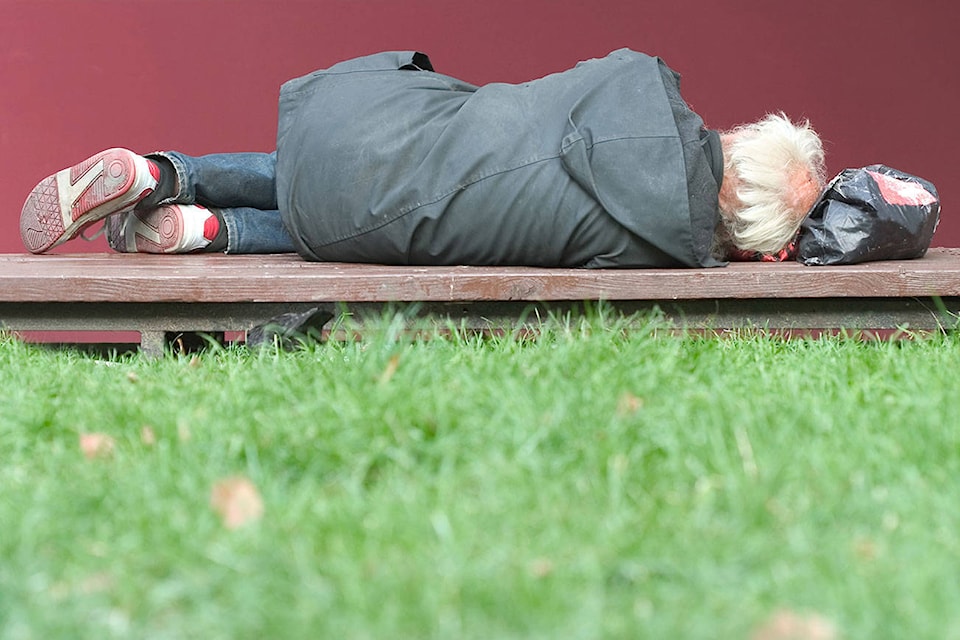The number of emergency shelter spaces grew significantly across the eastern Fraser Valley in the past three years but not enough to house everyone.
Results of the FVRD 2020 Homeless Count show that shelters spaces increased in Chilliwack, Mission and Hope.
But the shelter bed numbers actually decreased in Abbotsford, going from 230 spaces down to 166 over three years, but that dip relates specifically to a reduction in extreme weather beds, according to the survey results.
Chilliwack is the closest to housing all the unhoused with 203 emergency shelters beds, compared to the total number of homeless people which was pegged at 306. Chilliwack also built two modular supportive housing facilities in the past year, totalling 96 units, which made a big difference.
Abbotsford recorded 333 homeless in the 2020 count, with only 166 emergency shelter beds.
Mission’s number experiencing homelessness is 178, with 87 shelter spaces, while Hope saw 69 people homeless with 36 shelter spaces, according to the count.
Snapshot of homelessness in Hope
Across the communities of the Fraser Valley, from Abbotsford to Boston Bar, the amount of homeless individuals captured in the FVRD’s count has been on the rise since 2014. From the last count in 2017 to this year, the total number of homeless individuals surveyed went from 606 to 895.
As a percentage of the community, people with no fixed address and no place of their own make up 8 per cent of Hope and Boston Bar’s population.
The majority of homeless individuals in the eastern Fraser Valley (including Boston Bar and Hope as well as Kent and Harrison Hot Springs) were between the ages of 30 and 59. Homeless people over the age of 60 made up just under 20 per cent of those surveyed in this region. The report noted there has been an increase in older people who are homeless, both in Hope and Mission.
The majority of homeless people in the eastern Fraser Valley surveyed are men, just under 70 per cent, and 30 per cent are female.
Despite an increase in shelter spaces in Hope, the need still far exceeds the availability of temporary shelter. Hope has increased the number of shelter spaces from 12 four years ago to 20 today. During the activation of extreme weather between November to March, this number grows with 17 additional cots.
During the coronavirus pandemic these numbers have changed slightly, Gerry Dyble with the Hope and Area Transition Society clarified. The shelter currently has space for 10 people and 12 additional spaces in a motel
With 69 people identified as homeless, the report found people are seeking other forms of shelter outside the beds offered in the community. Across the eastern Fraser Valley, 16 people were living outside, while 33 were either couch surfing or living in a vehicle.
Living rough
Those surveyed for the homeless count faced a variety of challenges including addictions, mental health issues, physical disabilities and other medical conditions. Just over a quarter said they had been in ministry care.
Indigenous people were overrepresented among the homeless population. Despite being around 4 per cent of the general population, 22 per cent of homeless individuals in the region identified with some form of Aboriginal ancestry.
What caused people to be living rough varied, the report concluded, and included high rent and inadequate affordable, suitable and supportive housing. BC Housing is proposing to build a 52-unit supportive housing complex on Old Hope Princeton Way to meet this need, plans which have met with opposition from some community members who have raised concerns around the size of the development.
Read more: BC Housing puts in rezoning application for Hope supportive housing build
Other causes of homelessness cited included addiction, mental illness and family or relationship breakdown.
Editor’s note: An earlier version of this story incorrectly stated the number of shelter spaces in Hope. There are 20 spaces at Hope’s emergency shelter, and 17 additional cots are laid out during winter months when the shelter does their extreme weather response.
Do you have something to add to this story, or something else we should report on? Email:
emelie.peacock@hopestandard.com
